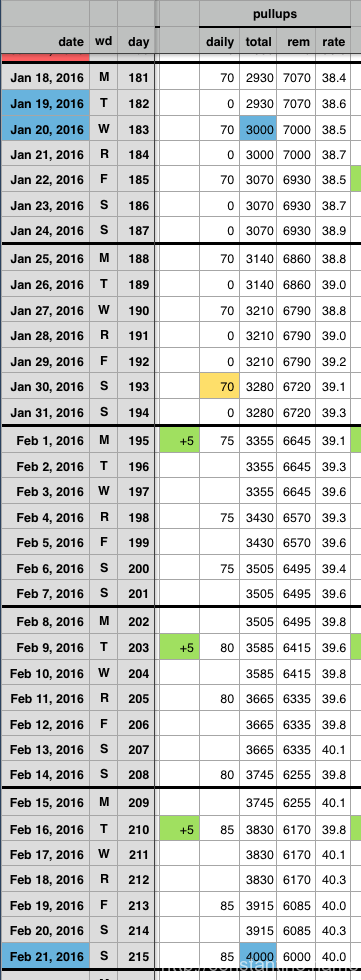(Part 18 of 36 in series, 10,000 Reps Project)
Whatever it is that you think you could NEVER do, figure out how to make a small step in the direction of your goal. Take that first step. Then look back and say, “well, now that I’ve come this far, I may as well go a little farther.”
I hope someone reads this, gets riled up, and thinks: “YEAH! I want to go for a walk!” …or a run, or a 5k, or swing on some bars, or walk a flight of stairs without gasping for breath, or lower my cholesterol, or be alive to play with my grand-kids. Whatever your goal is, GO CRUSH IT!
I remember when doing ONE STINKING PULLUP was inconceivable. Now I’m doing 70 — yes SEVENTY — per workout. The things that used to CRUSH me in class? …that stuff’s now my WARM-UP. Here’s a part of the worksheet that shows what’s going on with the pullups odometer. 3,000 reps is in the past (again, INCONCEIVABLE!) 4,000 is right on the horizon. Every workout through 4,000 is planned. A few more of the workouts are an identical, “all 70’s”, setup. Then, there are three weeks of bumping everything up +5.
In this screenshot, I’ve just completed January 27th/Day #190. The yellow block is the next planned workout; an exact repeat of today. There are more columns for the other activities, but now that all the activities’ numbers are in sync, they’re all the same. The pattern of workouts-to-rests is work-rest-work-rest-rest so that I have a regular, two-day rest over and over. Also, that’s a 5 day pattern so my workouts do not have the same weekdays — that’s really important to keep things from turning into “Monday’s suck” if I had a fixed weekly pattern. The double-rest also gives me a space to pull a workout one-day-earlier if I need to rearrange things, without making it into a killer two-days-in-a-row. (The things you think of when you do this for six months. D8 )

If anyone wants the details: The workouts are a ~45 minute circuit, based around 5 sets. Pushups, squats and bar-precisions are 5×14 (that’s 5 sets of 14 repititions.) The pullups are 5×6 (5 sets of 6 reps) plus 8×5 (8 sets of 5). So I do a set of pushups, squats and bar-pre’s to get really warmed up, then do a set of pullups between each set of everything else:
SET 1
14 pushups
14 squats
14 bar-precisions
SET 2
6 pullups
14 pushups
6 pullups
14 squats
6 pullups
14 bar-pre’s
SET 3
6 pullups
14 pushups
6 pullups
14 squats
5 pullups
14 bar-pre’s
SET 4
5 pullups
14 pushups
5 pullups
14 squats
5 pullups
14 bar-pre’s
SET 5
5 pullups
14 pushups
5 pullups
14 squats
5 pullups
14 bar-pre’s
FINALLY
5 final pullups (but sometimes I just wedge this in somewhere above)
40 second handstand (against wall)
30 second handstand
When I do a +5 bump, I just turn all those “14s” into “15s” and the 5-set layout makes a tidy +5. For pullups I can add a separate set of 5 at the end, or turn 5 5s into 5 6s, whatever — I have to see what I feel like in a few weeks.
ɕ
